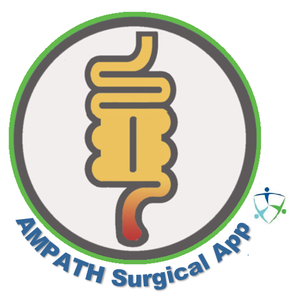
Welcome to the AMPATH Surgical App (ASAP) Curriculum
To strengthen surgical care in sub-Saharan Africa (SSA) and other LMICs, the World Health Organization (WHO) published a list of infrastructure, supplies, and procedures that should be available at all district-level hospitals. In an effort to improve the delivery of surgical care, our team narrowed the focus through a training needs assessment of surgical and anaesthesia post-graduate trainees in Kenya. We asked trainees to identify procedures they were expected to perform as general practitioners prior to receiving specialty training. One third of survey respondents identified the need for formal training in surgical skills pertaining to open appendectomy, a common procedure that corrects a time-sensitive and potentially life-threatening pathology
In this course, participants will develop a conceptual framework to assess patients with right lower quadrant pain and refine the psychomotor skills necessary to complete an open appendectomy.
Our goal is to enable medical doctors who have not completed formal surgical training to become confident and competent in the skills necessary to evaluate patients with right lower quadrant pain and perform an open appendectomy on an emergency basis. The impact of our training model both regionally and globally is the improvement of acute care surgery provision at WHO district-level hospitals.
The course is broken into four core modules: case presentation, building the model, complete procedure practice, and self-assessment. You can proceed through the modules in any order but it is recommended you proceed sequentially.
While the material is available on Appropedia, you may have a better learning experience if you download our free surgical education phone app.
Syllabus[edit | edit source]
Learning Objectives[edit | edit source]
- Discuss a differential diagnosis for right lower quadrant pain
- Recognize the features of acute appendicitis
- Describe the steps of an open appendectomy
- Demonstrate psychomotor skills necessary to complete an open appendectomy.
- Recognize the benefits of mental imagery
Module 1: Case Presentation[edit | edit source]
The learner should study the content of knowledge pages 1&2 and then take the readiness test. It is highly recommended that the learner be familiar with this content before proceeding to the skill pages.
Module 2: Basic Surgical Skills & Building the Model[edit | edit source]
The learner should review information in pages 1&2 and then build the open appendectomy model. The process of creating the model will be easier if information is previewed.
- Basic Surgical Skills Technique
- Instructions to Build your Model
- Instructions to Build Instrument Substitutes
Module 3: Skills Practice[edit | edit source]
The learner should review information in pages 1&2 prior to completing the open appendectomy. The specific steps described below form the foundation for the objective assessment.
- Review of the Cognitive Task Analysis: Real Operation
- Review of the Cognitive Task Analysis with a simulation model
- Introduction to Mental Imagery
- Application of Mental Imagery
Module 4: Self Assessment[edit | edit source]
The learner should review the rubric for assessment. The rubric follows the cognitive task analysis for the procedure but provides insight into which components of practice are essential for safe surgery.
Module 5: Adoption in Resource-Constrained Settings[edit | edit source]
For learners who do not have easy access to surgical instruments, below are some guides to building necessary instruments.
